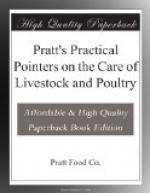The mash, because of its high protein content, is the real egg-maker. And during recent years there has been a tendency toward restricting the scratch feed and inducing the layers to eat more mash. Results seem to indicate that this plan is best, increasing the yield and reducing feed costs.
The laying ration now recommended by the New Jersey Agricultural Experiment Station is simple and efficient. This ration is made as follows:
Dry Mash lbs.
Wheat Bran 100 Wheat Middlings 100 Ground Oats (heavy) 100 Corn Meal 100
High-grade Fish Scrap or Meat
Scrap 100
Scratch Grain lbs.
Cracked Corn 200 Wheat 100 Oats (heavy) 100 Barley 100
The same institution has perfected the following feeding table showing what amount of scratch feed should be given the layers daily each month in the year. This is a most valuable guide, especially to the inexperienced poultryman. When the birds are fed scratch grain, as indicated, they will naturally eat enough mash from the open hoppers to meet their requirements.
Amount of Grain to Feed Layers Each Month in the Year
Months Amount Per Day Per Pounds For Each 100 Birds Feeding A.M. P.M. November 12 lbs. 4 lbs. 8 lbs. December 12 " 4 " 8 " January 12 " 4 " 8 " February 12 " 4 " 8 " March 12 " 4 " 8 " April 12 " 4 " 8 " May 10 " 4 " 6 " June 10 " 4 " 6 " July 8 " 3 " 5 " August 6 " 2 " 4 " September 5 " 2 " 3 " October 5 " 2 " 3 "
Study this question of mash and grain consumption, for if your birds are not getting enough protein mash, they cannot lay eggs in larger numbers.
* * * * *
Hatching the Chicks
For layers or broilers, hatch chicks early. For late markets and home use, you may bring off hatches at intervals throughout the entire summer.
The incubator and brooder are big helps where many chicks are hatched. Pratts Poultry Service Department will gladly advise you regarding makes of such machines which are giving general satisfaction.
Just a word of caution. Operate incubators and brooders in accordance with the directions furnished by the maker. Go slow in making changes.




